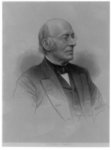December 8, 2017
Loud and Uncensored: William Lloyd Garrison’s Biggest Contributions in the Abolitionist Movement

As history has repeatedly shown, there is nothing that can conquer an individual with a persistent dream. No adversity is too strong and no action is too radical when one wishes to get one’s point across and make a difference in the world. This is very much the case for William Lloyd Garrison, the white abolitionist with strong passionate ideas about the structure and leadership of our country, especially in regards to slavery.
William Lloyd Garrison started expressing his love for writing his opinions at an extremely young age. His dreams of publishing his works led him to move to Boston, Massachusetts in 1829 at the age of twenty-four to become an editor for National Philanthropist. Although the newspaper over time proved to be unsuccessful, it gave him the opportunity to network with people that had seemingly similar ideals to his own. He became associated with the American Colonization Society, but that bridge was burned on July 4, 1829, when he gave his famous speech at Park Street Church.1
In that speech, Garrison openly criticized America, its ideas, and even the constitution. He states, “I say that our politics are rotten to the core. We boast of our freedom, who go shackled to the polls, year after year, by tens and hundreds and thousands! We talk of free agency, who are the veriest machines–the merest automata–in the hands of unprincipled jugglers!”2 He goes on to refer to the United States as “evil,” but more than anything, he seems to be the most concerned with the idea of slavery. This served as his opening speech as a leader in the abolitionist movement. The American Colonization Society quickly objected to the ill words used to describe the United States, and it was at that moment that he placed his own morals above the acceptance of any group.3 He disassociated himself from the American Colonization Society and decided to take on the fight on his own.
Garrison’s first step in expressing his ideas was starting a newspaper called The Liberator.4 This revolutionary newspaper debuted in 1831, and caused both praise and outrage from American citizens and officials alike for the next quarter century. His writings were known to be free and controversial, but like all other controversial topics, he had a large crowd of supporters. Once he knew he had plenty of attention, his actions began to correspond with his articles. He would say or do anything for the antislavery movement.
In 1854, he performed what many believe to be his most radical and passionate address of all time. During a July 4 speech, he set a copy of the constitution on fire and referred to it as “an agreement with hell.” He led the rest of the speech with the motto “No Union with Slaveholders.” This loud, expressive statement sparked a reaction even from people who did not even know of his event or cause.5 It did not take long for the news to spread. Newspapers were flooded with articles and political cartoons that displayed utter shock and confusion. A lot of the attention regarding this incident may have been negative, but it raised questions, such as “What’s going on here?” and “Who is he, and why his fury?” It made people listen and try to understand his cause even if they did not intend to do so. This brought so much attention to his cause and many people followed in his footsteps with their support.6
William Lloyd Garrison may have been a controversial figure, but he spoke in such a way that he was heard by all. He demonstrated that you didn’t have to be African American to be passionate about equal rights and he encouraged other white people to follow his example.
- Ronald Osborn, “William Lloyd Garrison and the United States Constitution: The Political Evolution of an American Radical,” Journal of Law and Religion 24 (December 2008): 82-85. ↵
- William Lloyd Garrison, “The Dangers of Slavery,” (address, Park Street Church, Boston, July 4, 1829). ↵
- Ronald Osborn, “William Lloyd Garrison and the United States Constitution: The Political Evolution of an American Radical,” Journal of Law and Religion 24 (December 2008): 82-85. ↵
- Ronald Osborn, “William Lloyd Garrison and the United States Constitution: The Political Evolution of an American Radical,” Journal of Law and Religion 24 (December 2008): 82-85. ↵
- Humanities, January 2013, s.v. “The Agitator William Lloyd Garrison and the Abolitionists,” by James Williford. ↵
- Fisher Banks, “What’s Going on Here?” Saturday Evening Post, 3 July 1954, 91. ↵
Tags from the story
Abolitionist
William Lloyd Garrison
Recent Comments
Vanessa Tombo
Your article brings light to a character some as have never heard of until now. When people are asked about the abolishment of slavery and its contributor people think of the names such as Abraham Lincoln, Fredrick Douglass, the Quakers, Thomas Clarkson and many others. Prior to reading your article, I thought I was well acquainted with the majority of people who used their platforms to give voice to the fellow Americans a voice. Thank you for such an astounding article.
21/01/2018
11:18 am
Auroara-Juhl Nikkels
Previous to your article, I had never heard of William Lloyd Garrison, but he is someone I wish I had learned about in one of my history classes. This is a man who set the Constitution on fire because he views slavery as evil and the United States as evil because they had slaves. He had radical actions, but sometimes radical actions are necessary in order to make radical changes.
21/01/2018
11:18 am